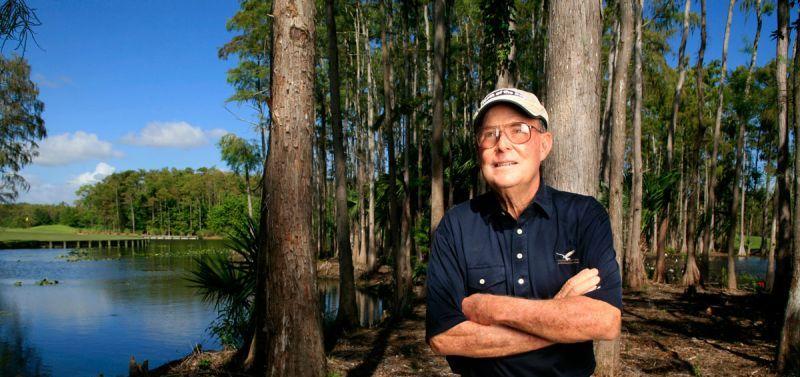
Three Kings of Course Design: Pete Dye
Editor’s Note: This is the second post in a three-part series highlighting some of golf’s most respected and accomplished course architects.
What do you look for in when looking for a new course to play? There are lots of things to consider… affordability, playability, reputation – and for some golfers, the course’s designer. We can thank gents like legendary links architect Paul B. “Pete” Dye, who’ve perfected the art of creating courses with equal parts challenge, natural beauty and enjoyment that make the game more fun for all of us.
Dye is one of the most, if not the most, influential golf course architects today and the list of courses he has designed over the past 50+ years is second to none. For his contributions to the game, Dye has won the Old Tom Morris Award from the Golf Course Superintendants Association of America (2003), the PGA Tour Lifetime Achievement Award (2005), and has been elected to the World Golf Hall of Fame (2008).
Always a golf enthusiast, Dye grew up on a golf course his father built on family land. Dye was a talented golfer himself, winning his state high school championship and several state and USGA amateur tournaments. He even competed in the 1957 U.S. Open where he finished ahead of both Arnold Palmer and Jack Nicklaus.

Pete Dye and his wife, Alice, began designing courses more than 50 years ago in the Indianapolis area. Photo by Florida Golf Magazine
Dye was always more fixated though, on the design and maintenance of golf courses. So, he and his wife, Alice, began designing courses in the Indianapolis area and the rest is history.
Dye’s courses incorporate a number of design characteristics that accommodate players of all levels. He starts most courses by creating five different tee boxes to account for the difficulty that distance presents. Through the years, he has also widened the fairways on his courses, placing more emphasis on strategic play to portions of the fairway for approach shots to greens. Dye typically creates large, undulating greens that are easy to hit, but difficult to score well on. Proximity to pins will be tantamount to a good score on a Pete Dye course.
The infusion of strategically-placed water and sand are also Dye trademarks that provide players of all handicaps with challenges that can make or break a round. Either way, you’re sure to appreciate the layout from one of the masters of the trade when you play a Pete Dye course.
Dye’s courses are some of the most famous in the golf world today. Here are three of our favorite Dye-designed GolfNow courses:
1. The TPC of Louisiana (New Orleans, LA) – Based in the wetlands of the Mississippi River delta, this course incorporates more than 100 bunkers and five ponds and is home to the Zurich Classic of New Orleans.
2. The TPC Sawgrass (Ponte Vedra Beach, FL) – This Players Championship host course was made for the precision player, with tightly-constructed, rolling fairways and water hazards throughout the layout. Home of the notorious island green 17th, a must-play on the bucket list of many golfers.
3. TPC Stadium Course at PGA West (La Quinta, CA) – This layout uses the natural desert surroundings to give magnificent views of the mountains throughout the round. Home to the Humana Challenge and two of the toughest finishing holes in all of golf – the par-3 17th, known as “Alcatraz” and the par-4 18th, lined by water hazards.
Check out these other great Pete Dye courses also available on GolfNow:
Arizona
• Arizona State University Karsten Golf Course – Tempe
• Red Mountain Ranch Country Club (Championship Course) – Mesa
California
• La Quinta Resort and Club (Dunes Course) – La Quinta
• La Quinta Resort and Club (Mountain Course) – La Quinta
• Lost Canyons Golf Club (Shadow Course) – Simi Valley
• Lost Canyons Golf Club (Sky Course) – Simi Valley
• The Westin Mission Hills Resort & Spa (South Course) – Rancho Mirage
Colorado
• Plum Creek Golf and Country Club – Castle Rock
• Gypsum Creek Golf Course – Gypsum
Connecticut
• Wintonbury Hills Golf Course – Bloomfield
Illinois
• Ruffled Feathers Golf Course – Lemont
Indiana
• Eagle Creek Golf Club (Pines and Sycamore Courses) – Indianapolis
• Plum Creek Golf Club – Carmel
• The Fort Golf Course (Fort Harrison State Park) – Indianapolis
• Birck Boilermaker Golf Complex at Purdue University (Kampen Course) – West Lafayette
• Oak Tree Golf Course (front nine) – Plainfield
• Mystic Hills Golf Course – Culver
• Forest Park – Brazil
Kentucky
• Kearney Hill Golf Links – Lexington
• Peninsula Golf Course – Lancaster
Maryland
• Harbourtowne Resort Country Club – St. Michaels
• Rum Pointe Seaside Golf Links – Berlin
Nevada
• Paiute Golf Club Resort (Snow, Sun, and Wolf Courses) – Las Vegas
North Carolina
• Oak Hollow Golf Course – High Point
South Carolina
• Prestwick Country Club – Myrtle Beach
• Barefoot Resort- Dye Course – Myrtle Beach
Virginia
• Virginia Oaks – Gainesville
Wisconsin
• Big Fish Golf Club – Hayward
Featured image courtesy of Links Magazine.

Leave a Reply
You must be logged in to post a comment.